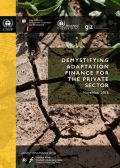
Tomorrow’s financial system will not look like today’s. Possibilities will be shaped by new entrants and technologies and by shifts in the global economy’s centre of gravity. Crises and innovation may present unpredictable and alternative pathways of change.
The Inquiry, with support from the OECD, therefore developed a set of scenarios to frame discussions of the possible future policy contexts within which a sustainable financial system needs to evolve. Each of the four scenarios described in Designing for Disruption: The UNEP Inquiry Scenarios (Global Nudges, Emerging Accords, State Patchworks and Technology Edges) reflects a potential future in which the financial system is aligned with sustainable development, albeit in different ways.
The Paulson Institute, together with the China’s Green Finance Committee, the Securities Industry and Financial Markets Association (SIFMA), the United Nations Environment Programme (UNEP) and Bloomberg Philanthropies, co-hosted an event on 16 April 2016 at the Bank of America in Washington, D.C. to explore the implications of the greening of the financial system for financial market actors and policymakers.
This briefing note, Green Finance: A Growing Imperative conveys the key messages from the event, which are:
